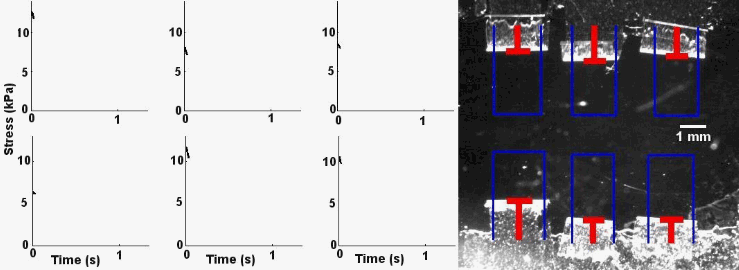Overview
Our research is focused on designing and building hybrid materials and devices. Microscale soft biological constructs, which retain their unique biological functionalities, are being interfaced with robust synthetic components to develop two distinct technologies: (1) Active bionanomaterials and (2) Quantitative pharmacological devices.
Muscle on a chip
Primary Investigator: Anna Grosberg, Ph.D
The “heart on a chip” is a microdevice that encapsulates multiple pieces of laminar muscle for in vitro studies of tissue contractility, structural properties, and electrophysiological function (Grosberg A, et al. “Ensembles of engineered cardiac tissues for physiological and pharmacological study: Heart on a chip.” Lab Chip, 2011). The design of such microdevices will give researches and companies an ability to perform tissue scale in vitro experiments to test their cell’s function and/or the effect of pharmacological agents. We are currently working on integrating the “heart on a chip” with other muscle types including stem-cell derived myocytes. Our design efforts are greatly enhanced by our lab’s variety of tools ranging from an optical mapping system and fluorescent microscopes to access to microfab facilities and the muscular thin film technology.

Higher throughput muscle on a chip
Primary Investigator: Ashutosh Agarwal, Ph.D
Cardiac valve on a chip
Primary Investigator: Kartik Balachandran, Ph.D
We are also interested in developing combinatory “organ on a chip” devices, and one of our research thrusts in this direction is the development of a valve on a chip. Our objective is to design a valve system with neural input that recapitulates the function of a valve in a scaled down on-chip device. This research thrust is motivated from recent secondary valvulotoxic effects of neurological drugs such as diet pills (Fenfluramine-Phentermine) and anti-depressants. We aim to use this device for high throughput testing of neurological and valve function in response to various pharmacological agents.

